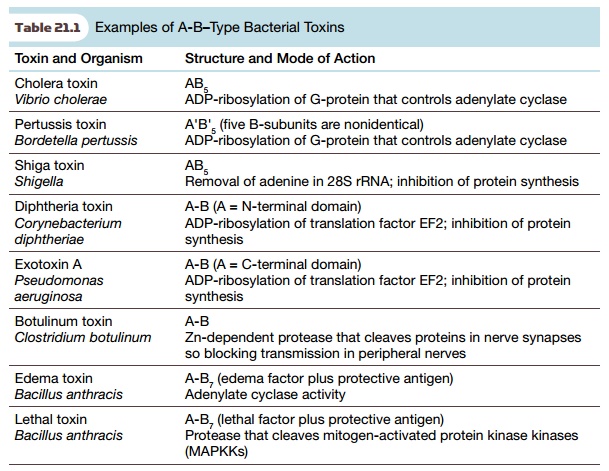Chapter: Biotechnology Applying the Genetic Revolution: Bacterial Infections
Bacterial Toxins
BACTERIAL TOXINS
In addition to invasion and
survival, many pathogenic bacteria also mount aggressive attacks against
eukaryotic cells by making toxins. In its broadest sense, the term toxin includes
any molecule that damages eukaryotic cells. Some toxic effects may be regarded
as “accidental,” whereas others are deliberate. For example, bacterial endotoxin
is actually the lipid A component of lipopolysaccharide (LPS) that forms part
of the outer membrane of gramnegative bacteria. If such bacteria are killed by
the immune system, their cell walls will disintegrate and release LPS. The CD14
receptor on immune cells binds the LPS, and this triggers the release of
cytokines. Simultaneous destruction of many bacteria will release large amounts
of LPS and may result in septic shock.
Nonetheless, most pathogenic
bacteria make one or more toxins that are designed to deliberately kill or
damage the cells of their host. Because these are secreted from still-living bacteria,
they are known as exotoxins . Most bacterial exotoxins are proteins, and they
may be subdivided into three groups based on their site of action:
(a) Type I toxins do not enter the target cell. They
trigger a harmful response by binding to a receptor on the cell surface. For
example, heat-stable toxin a (STa) is made by some pathogenic strains of E.
coli that cause diarrhea. STa is a hormone analog that binds to guanylate
cyclase in the animal cell membrane, causing overproduction of cyclic GMP.
(b) Type II toxins act on the cell membrane of the target
cell. Some degrade membrane lipids, and others create pores in the membrane. For
example, hemolysin A is made by some pathogenic strains of E. coli that
cause kidney damage. Hemolysin A was named for its ability to lyse red blood
cells, but it disrupts the membranes of many other types of animal cells also.
(c) Type III toxins enter the target cell. They consist of
a toxic factor (A-protein) together with a delivery system (B-protein). The A
(“active”) and B (“binding”) proteins may be separate molecules or may be
different domains of a single protein. Sometimes the delivery system consists
of multiple B-subunits and, conversely, cases are known where multiple A-proteins
share the same delivery system ( Table 21.1 ). These toxins are the most
interesting from a molecular viewpoint, and we will discuss a few selected
examples in more detail.

Related Topics